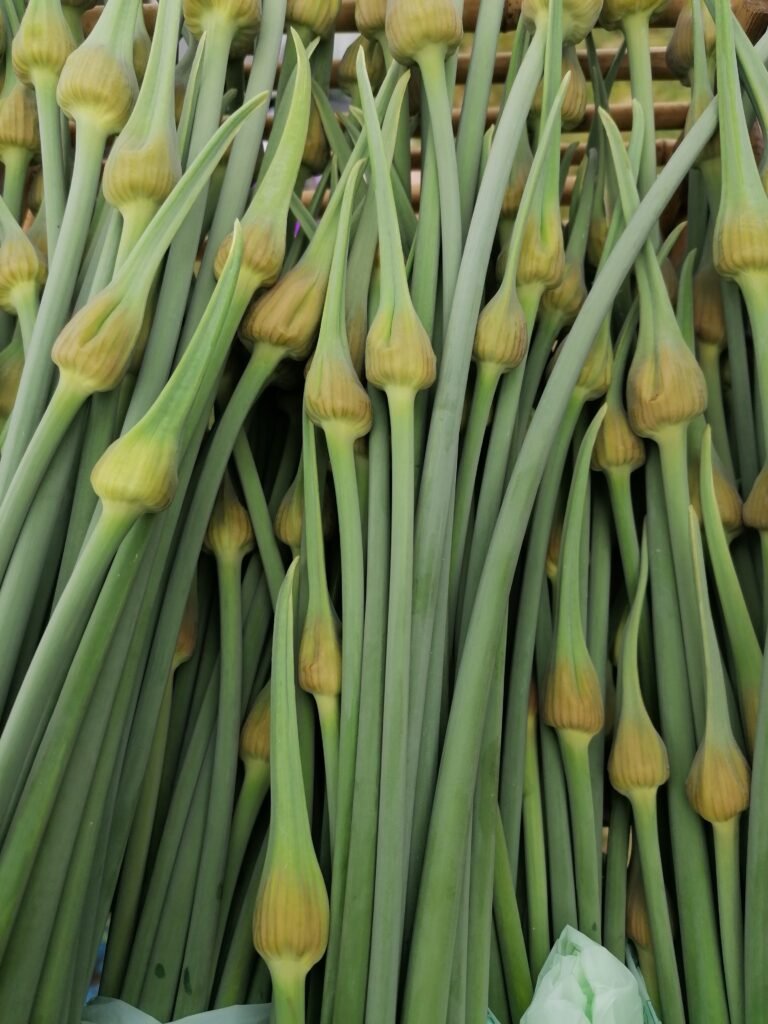
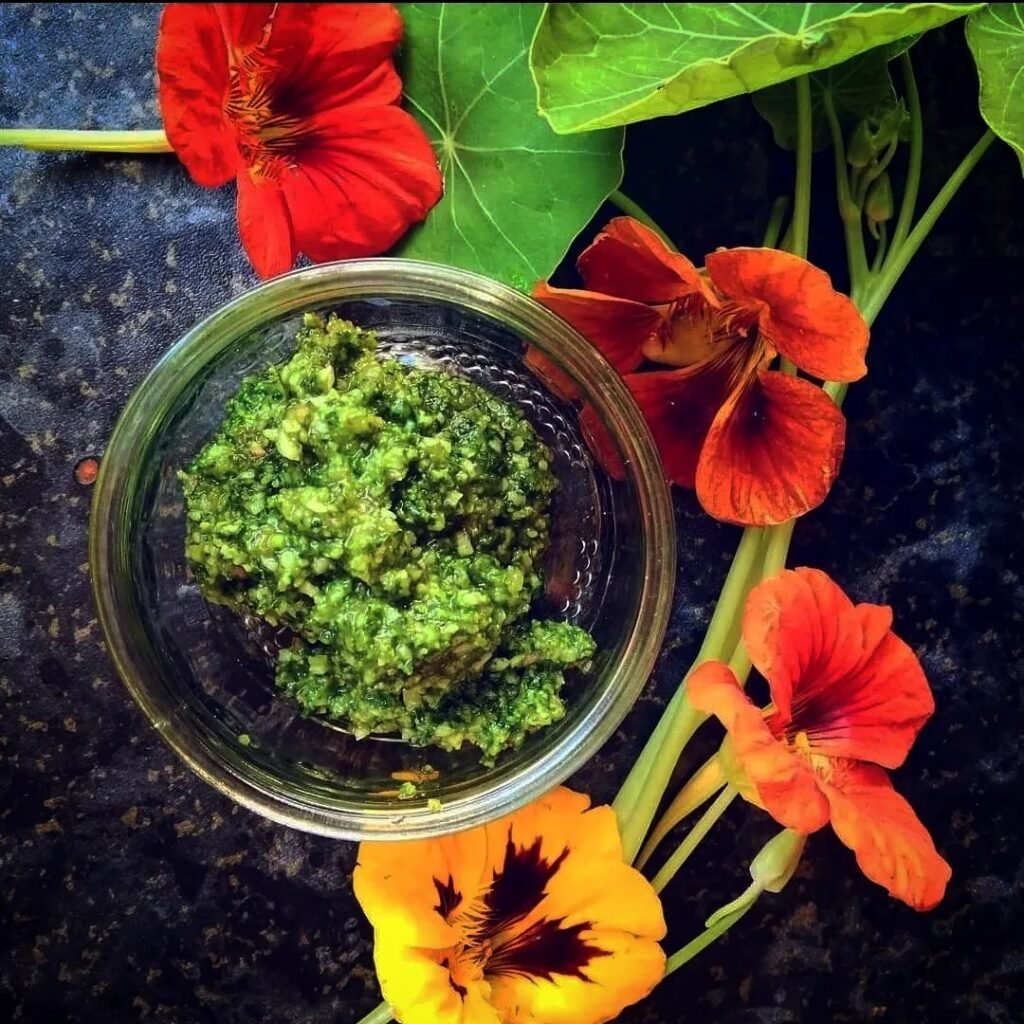
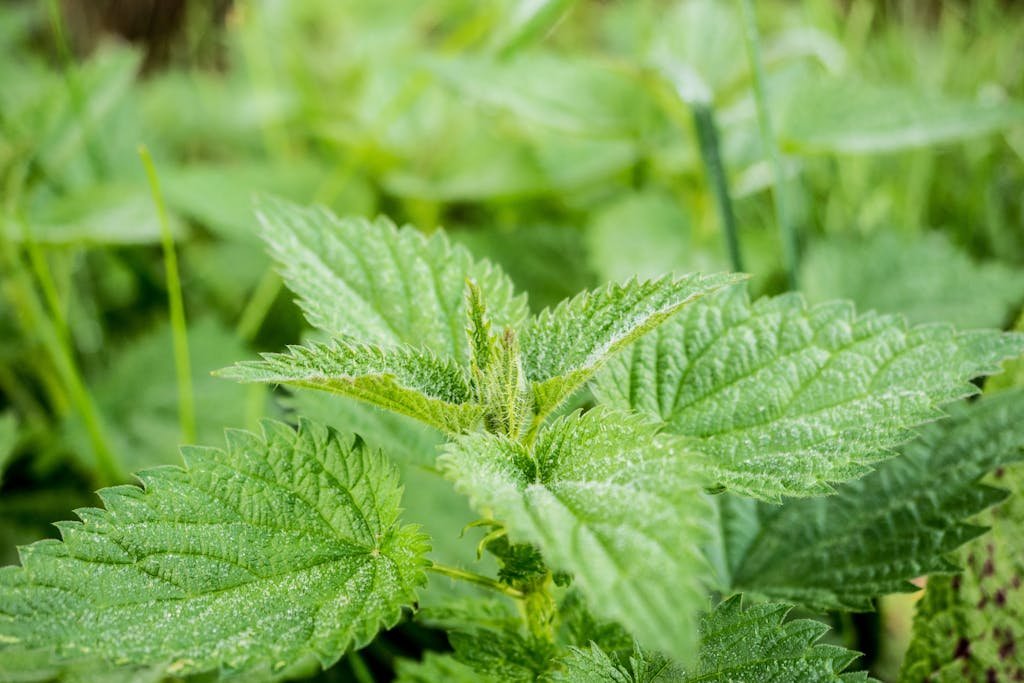
We made a Garlic Scape, Nettle and Nasturtium Pesto last week, and honestly, it might be our new favorite way to eat the garden. It’s a little wild, a little spicy, and bursting with everything we love about growing our own food.
Nasturtiums have always been one of my favorite plants. They’re easy to grow, full of color, and the the whole plant is edible. From leave, over seeds to flowers! You can scatter them over a salad, toss them into a wrap, or—my favorite—blend them into pesto. Their peppery bite makes everything pop.
Gar, on the other hand, is all about garlic. He’s been babying our Elephant garlic and cheering whenever the curly scapes twist just right. Garlic scapes are like spring’s little secret—they’re tender, garlicky, and make the dreamiest green sauce.
Now, nettles… nettles are a different story. We both grumble when it’s time to clear them out. They sting, they spread, and they always seem to grow exactly where you don’t want them. But—sigh—they’re packed with iron, vitamins, and all sorts of healing goodness. We may dread them, but we respect them too.
So we took a basket of the three—nasturtiums, garlic scapes, and nettles—and turned them into something bright, bold, and delicious. It’s the kind of pesto that feels like sunshine and soil all in one bite. And it’s proof that even the most annoying weeds can turn into something wonderful.
Let’s show you how we did it.
What Are Garlic Scapes? A Garden Gem Worth Waiting For
If you’ve ever grown hardneck garlic, you know the joy of seeing those curly green stems start to loop and twirl. Garlic scapes are like the garden’s secret gift—tender, twisty, and full of promise. We wait for them each year, just as eagerly as we do the bulbs. They don’t just look magical; they taste like spring garlic with a soft, green sweetness. And best of all, they’re packed with nutrients and garden goodness.
- Definition: the curly flowering stems of hardneck garlic plants
- When and how to harvest: usually in late spring or early summer, when the scapes make a full curl
- Flavor profile: like mild garlic with a hint of green and a touch of sweetness
- Nutritional highlights: full of antioxidants, vitamin C, and sulfur-rich compounds
- Kitchen uses: amazing in stir-fries, grilled whole, blended into dips—or our favorite, a fresh green pesto
Want to learn more? Here’s our full guide on garlic scapes and how to use them.

Growing & Using Nasturtiums: A Peppery Powerhouse
Nasturtiums might just be the easiest flowers to fall in love with. They’re bold, bright, and bloom like they mean it—spilling over pots, borders, and garden beds with cheerful, fiery petals. I plant them every spring, not just for their good looks, but because they do it all. Their leaves have a peppery zing, the flowers are edible, and they’re little heroes in the garden—keeping pests away and inviting bees to stay awhile. Plus, they’re packed with goodness and so simple to grow, even a beginner can feel like a pro.
- Easy-to-grow edible flower with vibrant petals and spicy, salad-ready leaves
- Popular varieties to try: Empress of India (deep red), Alaska (variegated leaves), and Jewel Mix (rainbow blooms)
- Companion planting benefits: naturally repels aphids and whiteflies, while attracting bees and butterflies
- Nutritional content: rich in vitamin C, iron, and natural antibiotic compounds
- How to harvest: pick leaves young and tender; snip flowers just before eating for the best flavor
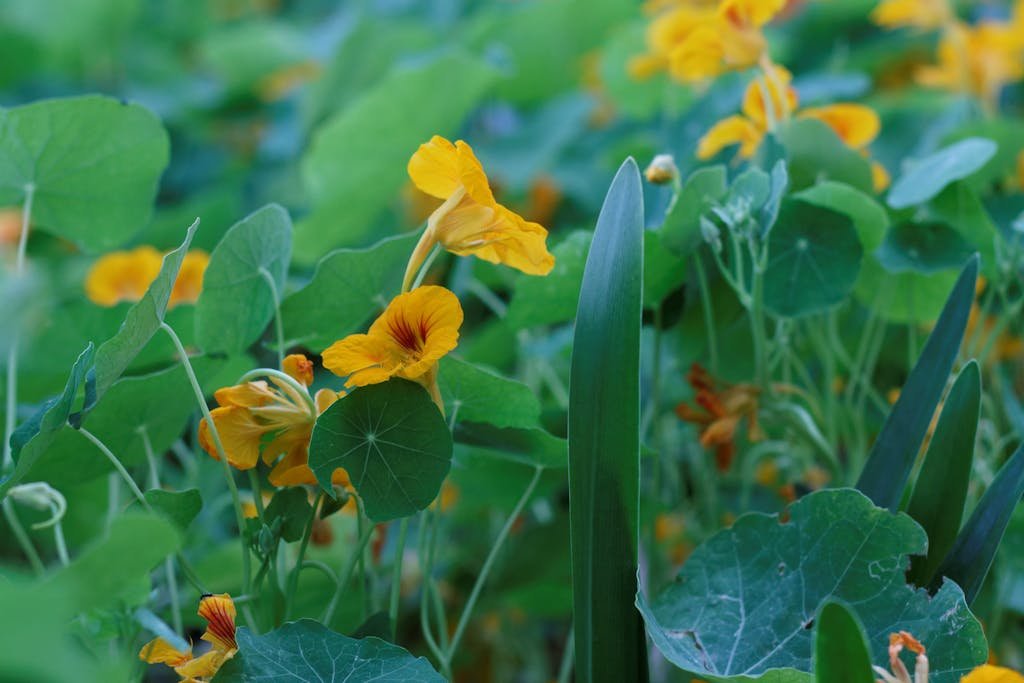
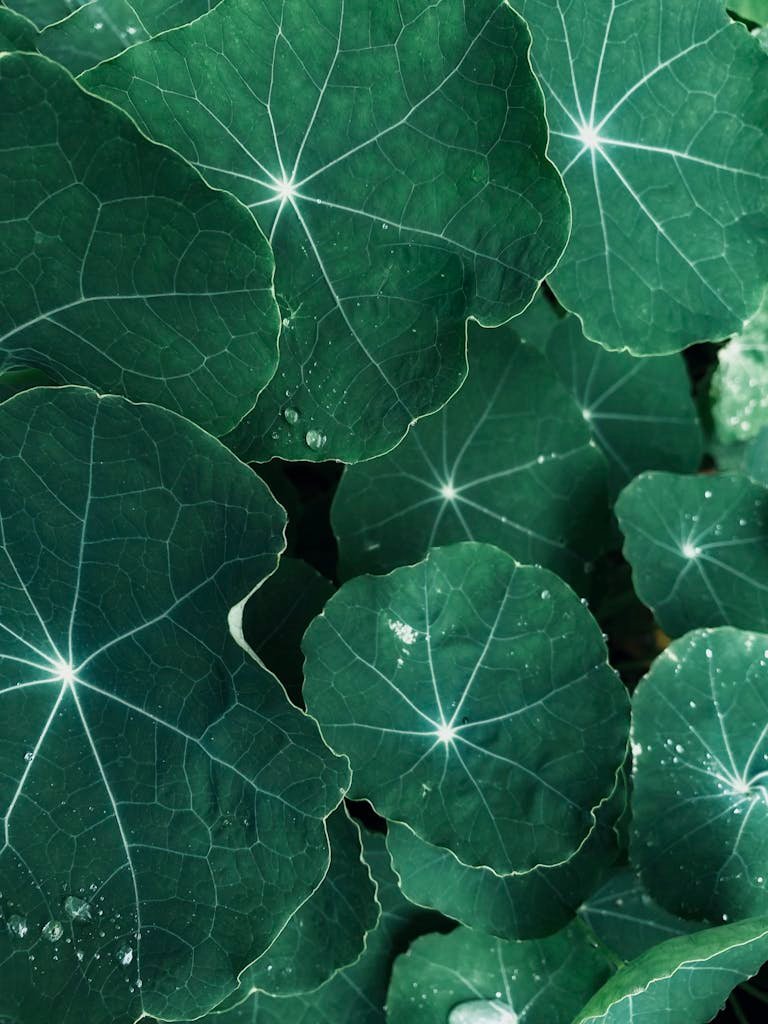
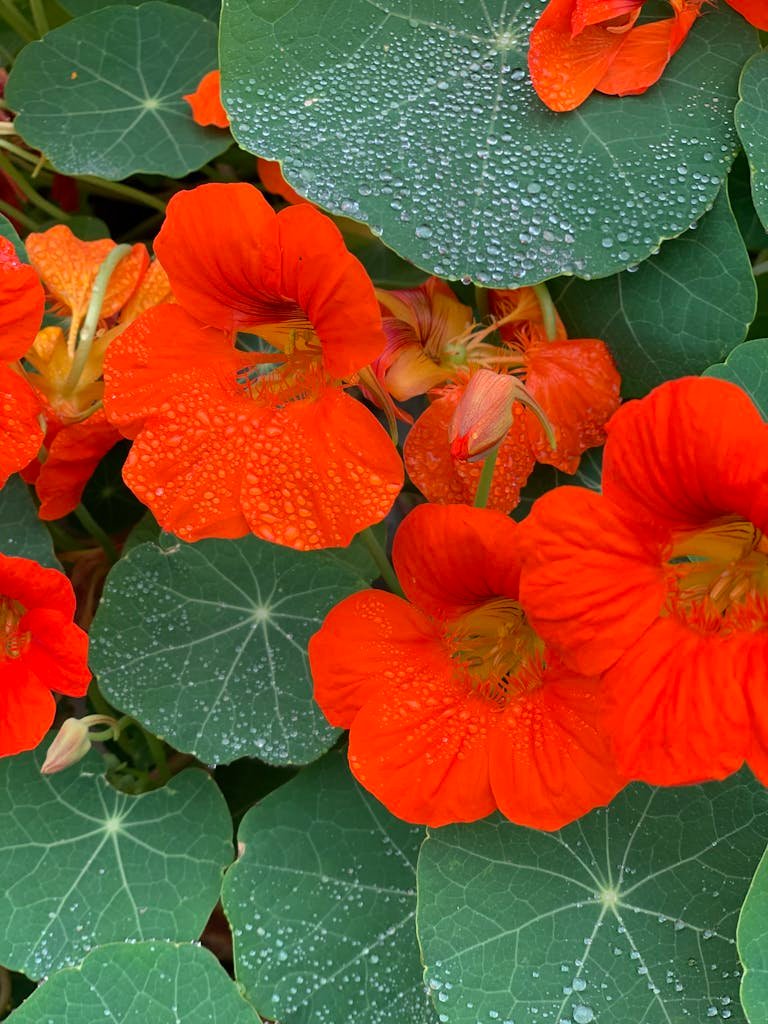
Meet the Mighty Nettle: How to Forage & Why You Should
Where and When to Find Stinging Nettles
Just when the garden starts stretching after a long winter nap, stinging nettles begin to show up. You’ll usually see them from March through early summer. They love rich, damp soil and often grow along hedgerows, forest paths, and riverbanks—and sometimes right in your own backyard. Look for young plants that are less than a foot tall. These tender leaves are the best for cooking. As nettles get older, they become tougher and can be harder to digest if eaten raw.
Ethical and Safe Foraging Practices
First things first—always forage with care. Never pick from roadsides or near places that may be sprayed with chemicals. And if you’re on someone else’s land, it’s only polite to ask for permission. When you’re harvesting, use gloves and wear long sleeves to avoid their sting. Just snip off the top few inches of each plant and move on. Only take what you’ll use, and leave plenty behind so the patch can keep growing for others (and for the bees!).
Nutritional Profile: A Green Superfood
Nettles might be pesky, but they’re packed with goodness. They’re full of iron, calcium, and protein—not to mention chlorophyll and vitamins A, C, and K. Some folks even call them nature’s multivitamin. They’re wonderful for giving you more energy, especially after a long winter.
Health Benefits: More Than Just a Weed
For years, nettles have been used in natural medicine. They’re known to help with allergies, joint pain, and inflammation. Some people even drink nettle tea to feel more energized. It’s amazing what a so-called weed can do, isn’t it?
How to Identify and Harvest Responsibly
Nettles are easy to spot once you know what to look for. They have jagged, heart-shaped leaves and square stems. Both the leaves and stems are covered in tiny hairs that sting when touched. That’s why gloves are so important! Use a pair of sharp scissors or garden shears to cut just the top few inches. Once you’re home, you can blanch them in boiling water for a minute to remove the sting before cooking.
Foraging Equipment: Tools of the Trade
To make foraging fun (and safe!), here are a few things we always bring along:
- Protective gloves – These are a must for avoiding stings.
- A long-sleeved shirt – Keeps your arms safe while staying cool.
- Garden shears or scissors – Makes clean cuts and speeds things up.
- A foraging basket or cloth bag – Lets the air flow so your nettles stay fresh.
We always keep a little foraging kit ready to go when we’re out walking in spring. You never know when a patch of nettles might be calling your name.
Preparing Nettles Safely (So You Don’t Get Stung)
First, it’s best to wear gloves when handling nettles. This way, you avoid the sting entirely. Yet, if you’re feeling confident, remember: sliding your fingers gently up the leaf stem (going with the direction of the hairs) often helps you avoid any pokes. It’s a skill—you learn the garden’s own language!
Next, let’s talk about blanching. Once you’ve gathered your nettles, pop them into boiling water for about 30–60 seconds. Then plunge them into ice water to stop the cooking. This simple step takes away the sting and keeps those bright green color and fresh taste.
After blanching, you can dry or freeze them to save for later. Spread them out on a tray to air-dry (for soups or tea), or pack them into freezer bags. Frozen nettles are perfect for smoothies, sauces, and winter pastas—you’ll be carrying a little spring magic with you!
Finally, remember there are other tasty ways to enjoy nettles. You can stir them into soups, steep them as tea, or fold them into saag (a creamy spinach-like dish). They pair beautifully with garlic, lemon, or coconut milk.
Why Garlic Scapes, Nettles & Nasturtiums Make the Ultimate Pesto Trio
Let’s talk pesto magic. Sure, basil gets all the attention—but if you’ve got garlic scapes, fresh nettles, and bright nasturtiums on hand, you’ve struck gold. Here’s why this trio works so well together.
First, it’s all about balance. Garlic scapes bring a gentle garlicky punch, nettles add that deep, earthy green taste, and nasturtiums offer a peppery zip and a pop of color. Together, they create a flavor that’s bold, fresh, and a little wild—in the best way.
Next, they each have a different texture that blends into the most creamy, dreamy pesto. The scapes are firm and smooth, nettles are leafy and soft (once blanched), and nasturtiums are delicate and floral. It’s like nature planned it this way.
And don’t forget the health perks! Garlic scapes are packed with antioxidants, nettles give you minerals and vitamins, and nasturtiums have natural anti-inflammatory powers. When you blend them together, it’s like giving your body a tasty little boost.
Plus, these plants are incredibly sustainable. They grow easily, don’t ask for much, and are often overlooked in the kitchen. So using them means less waste and more flavor—win-win!
Finally, it’s easy to make swaps. Vegan? Skip the cheese and add a squeeze of lemon or a spoon of miso. Nut-free? Use sunflower seeds or pumpkin seeds instead. Want it creamy? A little Parmesan or nutritional yeast does the trick.
This pesto isn’t just tasty—it’s thoughtful, seasonal, and made with what’s already growing around you. A perfect way to turn garden leftovers into something that feels fancy.
Garlic Scape & Nettle Pesto Pasta Recipe

Garlic Scape, Nasturtium & Nettle Pesto Pasta
Ingredients
For the Pesto
- 100 g fresh nettles young tops, blanched and drained
- 80 g Garlic scapes chopped
- 30 g Nasturtium leaves and pedals
- 50 g Pecan nuts toasted
- 50 g Parmesan or vegan cheese grated
- 150 ml Olive oil
- 15 ml Lemon juice about 1/2 lemon
- Salt to taste
- Pinch of chili flakes optional
For the Pasta
- 300 g dried pasta
- Salt and olive oil for the water
Instructions
- Harvest & prep: Wearing gloves, pick the top 4–6 leaves of young nettles. Rinse thoroughly and blanch in boiling water for 1 minute to remove the sting. Drain and let cool.
- Blend the pesto: In a blender or food processor, combine blanched nettles, chopped garlic scapes, nasturtium leaves/petals, seeds, lemon juice, cheese (if using), and salt. Pulse while slowly adding olive oil until smooth. Adjust thickness with pasta water if needed.
- Cook pasta: In a large pot, bring salted water to a boil. Cook pasta according to package directions. Save 100 ml of pasta water before draining.
- Toss and serve: Mix pesto with hot pasta. Add a splash of pasta water to help coat the noodles evenly. Taste and adjust seasoning. Top with extra cheese, chili flakes, or lemon zest if you like.
Notes
- Freezing: Pesto freezes beautifully. Spoon into ice cube trays or small jars and freeze for up to 3 months. Skip the cheese if freezing and stir it in fresh when serving.
- Make it nut-free: Use sunflower or pumpkin seeds instead of nuts.
- Vegan option: Swap cheese for 1 Tbsp (15 g) white miso or 2 Tbsp nutritional yeast for depth and saltiness.
- No nasturtiums? No problem. Just skip or sub in a small handful of spinach or parsley for color.
Conclusion
And just like that, you’ve turned a bundle of wild greens and curly garlic shoots into a bowl of comfort food! Isn’t it amazing what a little foraging and blending can do? From stingy nettles to peppery nasturtiums, every bite is packed with goodness from the garden—or the hedgerow if you’re lucky.
This pesto pasta is more than a meal. It’s a way to connect with the seasons, use what’s growing right now, and fill your kitchen with simple joy. You don’t need anything fancy—just a bit of time, a dash of creativity, and maybe a pair of gloves for those nettles!
If you’ve frozen some pesto cubes for later, you’ll thank yourself on a busy evening. Just toss one into warm pasta, spread it on toast, or stir it into a soup. Honestly, it’s like having a little bit of summer in a jar.
And remember, this recipe is only the beginning. Once you start looking at “weeds” and garden extras as ingredients, the whole world opens up. So next time you’re out in the garden or on a walk, take a second look. You might be stepping on dinner.
Want more seasonal recipes, wild food tips, and garden ideas? You’ll find plenty more waiting over on the June in the Kitchen. Go have a look—you never know what inspiration is blooming today.
